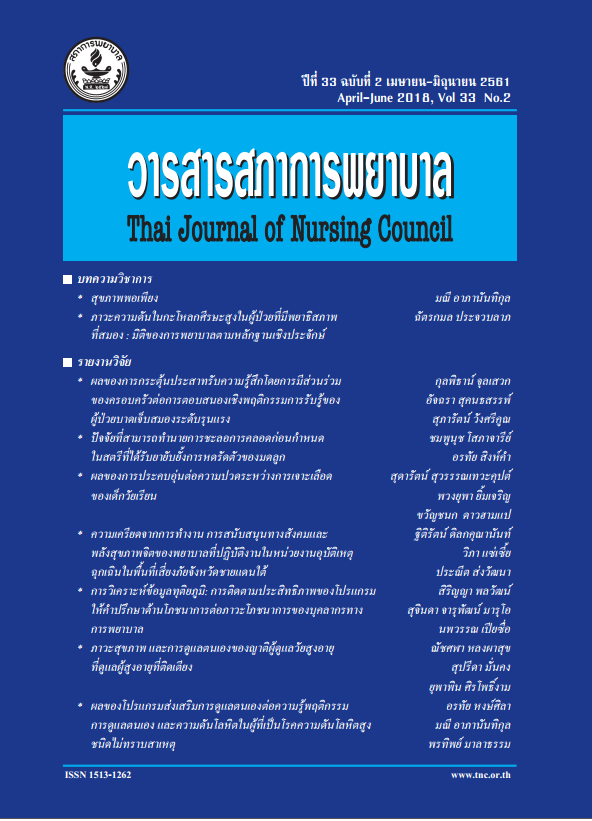Factors predicting delaying in preterm birth among women who received tocolysis
Keywords:
tocolysis, delaying in preterm birth, pregnancyAbstract
Abstract:
Objective: To identify predictive factors in delaying preterm birth among women
who received tocolysis.
Design: Descriptive-predictive study.
Procedure: This study was conducted on 153 women recruited by means of convenient
sampling. The participants, all of whom had spontaneous preterm labour, were treated
in a labour and delivery unit and were given tocolysis to inhibit preterm birth. Data were
collected using a personal information questionnaire, a pregnancy and maternal care
questionnaire, and an anxiety questionnaire. All of the questionnaires were validated
by experts and had a content validity index of 1.00, whilst the anxiety questionnaire had
a reliability index of 0.82. Hierarchical multiple regression was used for data analysis.
Results: The predictive factors identifed consisted of childbirth-related factors
(i.e., length of labour pain prior to hospitalisation, cervical effacement, duration of
spontaneous prior to hospitalisation, and interval of uterine contraction), a psychosocial
factor (i.e., anxiety), and personal factors (i.e., maternal age and pre-pregnancy BMI). These
factors were able to predict 78.30% of delaying in preterm birth (F = 26.80, p < .001).
Cervical effacement was identifed as the most powerful predictive factor (Beta = -0.94,
t = -13.24, p < .001), followed by the duration of spontaneous ruptured membranes prior
to hospitalisation (Beta = -0.30, t = -4.26, p < .001), interval of uterine contraction
(Beta = 0.22, t = 3.17, p < .01), and anxiety (Beta = -0.23, t = 3.21, p < .01). On the
other hand, length of labour pain prior to hospitalisation, maternal age, and pre-pregnancy
BMI were not found to have signifcant predictive power (p > 0.05).
Recommendations: Both nurses and pregnant women play an important role in
the delaying in preterm birth. Nurses should, therefore, advise pregnant women to
assess their uterine contraction and decide to go to hospital before the contraction becomes
more frequent that it may cause spontaneous rupture of membranes. In addition, during
hospitalisation, nurses should assess and plan to reduce pregnant women’s anxiety in
order to delay preterm birth.
Downloads
References
1. Urairoekkun C. Appropriate risk factors for preterm labour screening. Journal of Health Science 2017; 26(supp1): s64-9. (In Thai)
2. Strategy and Planning Division, Minisry of Public Health. Public healh statistics A.D.2016. Nonthaburi: Strategy and Planning Division, Ministry of Public Health; 2016. (In Thai)
3. Matthews TJ, MacDorman MF, Thoma ME. Infant mortality statistics from the 2013 period linked birth/ infant death data set. Natl Vital Stat Rep 2015; 64(9):1-30.
4. Watkins WJ, Kotecha SJ, Kotecha S. All-cause mortality of low birthweight infants in infancy, childhood, and adolescence: population study of England and Wales. PLoS Med 2016; 13(5): e1002018.
5. World Health Organization. WHO recommendations on interventions to improve preterm birth outcomes. Geneva: WHO press; 2015.
6. Carlo WA, McDonald SA, Fanaroff AA, Vohr BR, Stoll BJ, Ehrenkranz RA. Association of antenatal corticosteroids with mortality and neurodevelopmental outcomes among infants born at 22 to 25 weeks’ gestation. JAMA 2011; 306 (21): 2348-58.
7. Kiatsuda D, Thinkhamrop J, Prasertcharoensuk W. Success rate in preterm uterine contraction inhibition with tocolytic agents in a tertiary care center. Int J Womens Health 2016; 8: 663–7.
8. Althabe F, Belizán JM, McClure EM, HemingwayFoday J, Berrueta M, Mazzoni A, et al. A populationbased, multifaceted strategy to implement antenatal corticosteroid treatment versus standard care for the reduction of neonatal mortality due to preterm birth in low-income and middle-income countries: the ACT cluster-randomised trial. Lancet 2015; 385(9968):629-39.
9. Cunningham FG, Leveno KJ, Bloom SL, Hauth JC, Rouse DJ, Spong CY. Williams Obstetrics. 23rd ed.New York: McGraw-Hill; 2010.
10. Staneva A, Bogossian F, Pritchard M, Withowski A. The effect of maternal anxiety, depression, and perceived stress during pregnancy on preterm birth: a systematic review. Women Birth 2015; 28(3):179-93.
11. Kane HS, Schetter CD, Glynn LM, Hobel CJ, Sandman CA. Pregnancy anxiety and prenatal trajectories. Biol Psychol 2014; 100: 13-9.58
12. Stewart CP, Oaks BM, Laugero KD, Ashorn U, Harjunmaa U, Kumwenda C. et al. Maternal cortisol and stress are associated with birth outcomes, but are not affected by lipid-based nutrient supplements during pregnancy: an analysis
of data from a randomized controlled trial in rural Malawi. BMC Pregnancy Childbirth 2015; 15(1): 346.
13. Reinl EL, England SK. Fetal-to-maternal signaling to initiate parturition. J Clin Invest 2015; 125(7): 2569-71.
14. Laopaiboon M, Lumbiganon P, Intarut N, Mori R,Ganchimeg T, Vogel JP, et al. Advanced maternal age and pregnancy outcomes: a multicountry assessment. BJOG 2014; 121(suppl1): 49-56.
15. Di Renzo GC, Giardina I, Rosati A, Clerici G, Torricelli M, Petraglia F. Maternal risk factors for preterm
birth: a country-based population analysis. Eur J Obstet Gynecol Reprod Biol 2011; 159(2):342-6.
16. Hendler I, Goldenberg RL, Mercer BM, Iams JD, Meis PJ, Moawad AH, et al. The preterm prediction study: association between maternal body mass index and spontaneous and indicated preterm birth.Am J Obstet Gynecol 2005; 192(3): 882–6.
17. Torloni MR, Betrán AP, Daher S, Widmer M, Dolan SM, Menon R, et al. Maternal BMI and preterm birth: a systematic review of the literature with meta-analysis. J Matern Fetal Neonatal Med 2009;22(11): 957-70.
18. Romero R, Espinoza J, Goncalves, LF, Kusanovic JP, Friel LA, Nien JK. Inflammation in preterm and term
labour and delivery. Semin Fetal Neonatal Med 2006; 11(5): 317-26.
19. Ramsay JE, Ferrell WR, Crawford L, Wallace AM, Greer IA, Sattar N. Maternal obesity is associated with dysregulation of metabolic, vascular, and inflammatory pathways. J Clin Endocrinol Metab 2002; 87(9): 4231-37.
20. Soltani H, Fraser RB. A longitudinal study of maternal anthropometric changes in normal weight, overweight and obese women during pregnancy and postpartum. Br J Nutr 2000; 84(1): 95-101.
21. Fontana L, Eagon JC, Trujillo ME, Scherer PE, Klein S. Visceral fat adipokine secretion is associated with systemic inflammation in obese humans. Diabetes 2007; 56(4):1010-13.
22. Faul F, Erdfelder E, Buchner A, Lang A. G*Power version 3.1.2 [computer software]. Universität Kiel, Germany; 2008. Retrieved from http://www.psycho.uni-duesseldorf.de/abteilungen/aap/gpower3/download-and-register
23. Faul F, Erdfelder E, Buchner A, Lang A. Statistical power analyses using G*Power 3.1: Tests for correlation and regression analyses. Behavior Research Methods 2009; 41: 1149-60.
24. Cohen J. Statistical power analysis for the behavioral Sciences. 2nd ed. New Jersey: Lawrence Erlbaum Associates; 1988.
25. Sopajaree C, Ratchukul S. Anxiety of frst-time expectant parents in high-risk pregnancy: A phenomenological
study. Journal of Nursing Science, Chulalongkorn University 2002; 14(3): 1-11. (In Thai)
26. Schmidt AF, Finan C. Linear regression and the normality assumption. J Clin Epidemiol 2018; 98:146-51.
27. Gaillard R, Arends LR, Steegers EAP, Hoffman A, Jaddoe VWV. Second and third trimester placental
hemodynamics and the risks of pregnancy complications:The generation R study. Am J Epidemiol 2013;177(8): 743-54.








